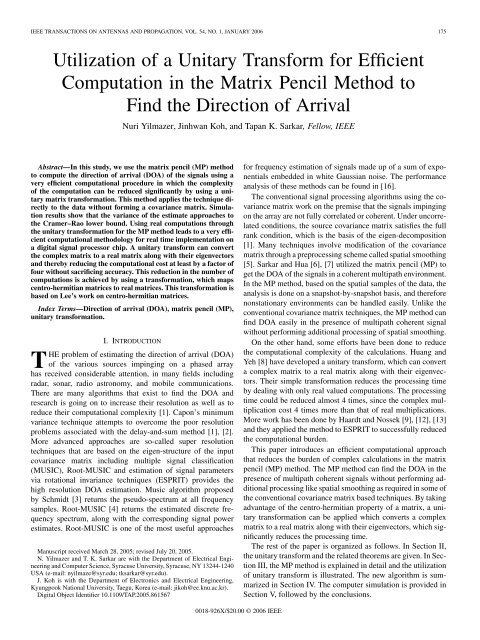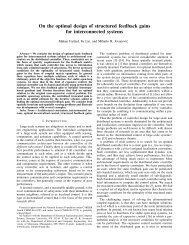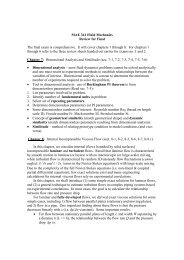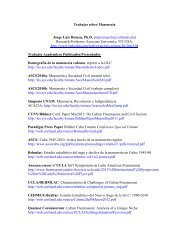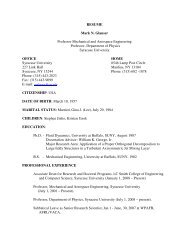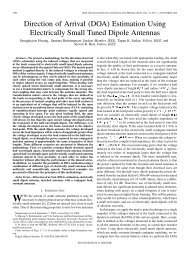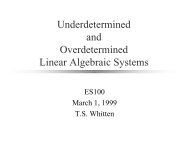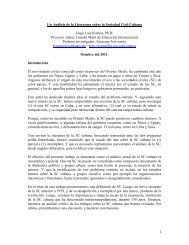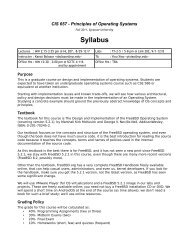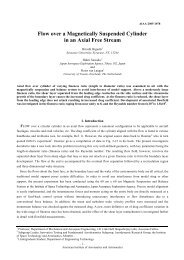Utilization of a Unitary Transform for Efficient Computation in the ...
Utilization of a Unitary Transform for Efficient Computation in the ...
Utilization of a Unitary Transform for Efficient Computation in the ...
You also want an ePaper? Increase the reach of your titles
YUMPU automatically turns print PDFs into web optimized ePapers that Google loves.
IEEE TRANSACTIONS ON ANTENNAS AND PROPAGATION, VOL. 54, NO. 1, JANUARY 2006 175<br />
<strong>Utilization</strong> <strong>of</strong> a <strong>Unitary</strong> <strong>Trans<strong>for</strong>m</strong> <strong>for</strong> <strong>Efficient</strong><br />
<strong>Computation</strong> <strong>in</strong> <strong>the</strong> Matrix Pencil Method to<br />
F<strong>in</strong>d <strong>the</strong> Direction <strong>of</strong> Arrival<br />
Nuri Yilmazer, J<strong>in</strong>hwan Koh, and Tapan K. Sarkar, Fellow, IEEE<br />
Abstract—In this study, we use <strong>the</strong> matrix pencil (MP) method<br />
to compute <strong>the</strong> direction <strong>of</strong> arrival (DOA) <strong>of</strong> <strong>the</strong> signals us<strong>in</strong>g a<br />
very efficient computational procedure <strong>in</strong> which <strong>the</strong> complexity<br />
<strong>of</strong> <strong>the</strong> computation can be reduced significantly by us<strong>in</strong>g a unitary<br />
matrix trans<strong>for</strong>mation. This method applies <strong>the</strong> technique directly<br />
to <strong>the</strong> data without <strong>for</strong>m<strong>in</strong>g a covariance matrix. Simulation<br />
results show that <strong>the</strong> variance <strong>of</strong> <strong>the</strong> estimate approaches to<br />
<strong>the</strong> Cramer–Rao lower bound. Us<strong>in</strong>g real computations through<br />
<strong>the</strong> unitary trans<strong>for</strong>mation <strong>for</strong> <strong>the</strong> MP method leads to a very efficient<br />
computational methodology <strong>for</strong> real time implementation on<br />
a digital signal processor chip. A unitary trans<strong>for</strong>m can convert<br />
<strong>the</strong> complex matrix to a real matrix along with <strong>the</strong>ir eigenvectors<br />
and <strong>the</strong>reby reduc<strong>in</strong>g <strong>the</strong> computational cost at least by a factor <strong>of</strong><br />
four without sacrific<strong>in</strong>g accuracy. This reduction <strong>in</strong> <strong>the</strong> number <strong>of</strong><br />
computations is achieved by us<strong>in</strong>g a trans<strong>for</strong>mation, which maps<br />
centro-hermitian matrices to real matrices. This trans<strong>for</strong>mation is<br />
based on Lee’s work on centro-hermitian matrices.<br />
Index Terms—Direction <strong>of</strong> arrival (DOA), matrix pencil (MP),<br />
unitary trans<strong>for</strong>mation.<br />
I. INTRODUCTION<br />
THE problem <strong>of</strong> estimat<strong>in</strong>g <strong>the</strong> direction <strong>of</strong> arrival (DOA)<br />
<strong>of</strong> <strong>the</strong> various sources imp<strong>in</strong>g<strong>in</strong>g on a phased array<br />
has received considerable attention, <strong>in</strong> many fields <strong>in</strong>clud<strong>in</strong>g<br />
radar, sonar, radio astronomy, and mobile communications.<br />
There are many algorithms that exist to f<strong>in</strong>d <strong>the</strong> DOA and<br />
research is go<strong>in</strong>g on to <strong>in</strong>crease <strong>the</strong>ir resolution as well as to<br />
reduce <strong>the</strong>ir computational complexity [1]. Capon’s m<strong>in</strong>imum<br />
variance technique attempts to overcome <strong>the</strong> poor resolution<br />
problems associated with <strong>the</strong> delay-and-sum method [1], [2].<br />
More advanced approaches are so-called super resolution<br />
techniques that are based on <strong>the</strong> eigen-structure <strong>of</strong> <strong>the</strong> <strong>in</strong>put<br />
covariance matrix <strong>in</strong>clud<strong>in</strong>g multiple signal classification<br />
(MUSIC), Root-MUSIC and estimation <strong>of</strong> signal parameters<br />
via rotational <strong>in</strong>variance techniques (ESPRIT) provides <strong>the</strong><br />
high resolution DOA estimation. Music algorithm proposed<br />
by Schmidt [3] returns <strong>the</strong> pseudo-spectrum at all frequency<br />
samples. Root-MUSIC [4] returns <strong>the</strong> estimated discrete frequency<br />
spectrum, along with <strong>the</strong> correspond<strong>in</strong>g signal power<br />
estimates. Root-MUSIC is one <strong>of</strong> <strong>the</strong> most useful approaches<br />
Manuscript received March 28, 2005; revised July 20, 2005.<br />
N. Yilmazer and T. K. Sarkar are with <strong>the</strong> Department <strong>of</strong> Electrical Eng<strong>in</strong>eer<strong>in</strong>g<br />
and Computer Science, Syracuse University, Syracuse, NY 13244-1240<br />
USA (e-mail: nyilmaze@syr.edu; tksarkar@syr.edu).<br />
J. Koh is with <strong>the</strong> Department <strong>of</strong> Electronics and Electrical Eng<strong>in</strong>eer<strong>in</strong>g,<br />
Kyungpook National University, Taegu, Korea (e-mail: jikoh@ee.knu.ac.kr).<br />
Digital Object Identifier 10.1109/TAP.2005.861567<br />
<strong>for</strong> frequency estimation <strong>of</strong> signals made up <strong>of</strong> a sum <strong>of</strong> exponentials<br />
embedded <strong>in</strong> white Gaussian noise. The per<strong>for</strong>mance<br />
analysis <strong>of</strong> <strong>the</strong>se methods can be found <strong>in</strong> [16].<br />
The conventional signal process<strong>in</strong>g algorithms us<strong>in</strong>g <strong>the</strong> covariance<br />
matrix work on <strong>the</strong> premise that <strong>the</strong> signals imp<strong>in</strong>g<strong>in</strong>g<br />
on <strong>the</strong> array are not fully correlated or coherent. Under uncorrelated<br />
conditions, <strong>the</strong> source covariance matrix satisfies <strong>the</strong> full<br />
rank condition, which is <strong>the</strong> basis <strong>of</strong> <strong>the</strong> eigen-decomposition<br />
[1]. Many techniques <strong>in</strong>volve modification <strong>of</strong> <strong>the</strong> covariance<br />
matrix through a preprocess<strong>in</strong>g scheme called spatial smooth<strong>in</strong>g<br />
[5]. Sarkar and Hua [6], [7] utilized <strong>the</strong> matrix pencil (MP) to<br />
get <strong>the</strong> DOA <strong>of</strong> <strong>the</strong> signals <strong>in</strong> a coherent multipath environment.<br />
In <strong>the</strong> MP method, based on <strong>the</strong> spatial samples <strong>of</strong> <strong>the</strong> data, <strong>the</strong><br />
analysis is done on a snapshot-by-snapshot basis, and <strong>the</strong>re<strong>for</strong>e<br />
nonstationary environments can be handled easily. Unlike <strong>the</strong><br />
conventional covariance matrix techniques, <strong>the</strong> MP method can<br />
f<strong>in</strong>d DOA easily <strong>in</strong> <strong>the</strong> presence <strong>of</strong> multipath coherent signal<br />
without per<strong>for</strong>m<strong>in</strong>g additional process<strong>in</strong>g <strong>of</strong> spatial smooth<strong>in</strong>g.<br />
On <strong>the</strong> o<strong>the</strong>r hand, some ef<strong>for</strong>ts have been done to reduce<br />
<strong>the</strong> computational complexity <strong>of</strong> <strong>the</strong> calculations. Huang and<br />
Yeh [8] have developed a unitary trans<strong>for</strong>m, which can convert<br />
a complex matrix to a real matrix along with <strong>the</strong>ir eigenvectors.<br />
Their simple trans<strong>for</strong>mation reduces <strong>the</strong> process<strong>in</strong>g time<br />
by deal<strong>in</strong>g with only real valued computations. The process<strong>in</strong>g<br />
time could be reduced almost 4 times, s<strong>in</strong>ce <strong>the</strong> complex multiplication<br />
cost 4 times more than that <strong>of</strong> real multiplications.<br />
More work has been done by Haardt and Nossek [9], [12], [13]<br />
and <strong>the</strong>y applied <strong>the</strong> method to ESPRIT to successfully reduced<br />
<strong>the</strong> computational burden.<br />
This paper <strong>in</strong>troduces an efficient computational approach<br />
that reduces <strong>the</strong> burden <strong>of</strong> complex calculations <strong>in</strong> <strong>the</strong> matrix<br />
pencil (MP) method. The MP method can f<strong>in</strong>d <strong>the</strong> DOA <strong>in</strong> <strong>the</strong><br />
presence <strong>of</strong> multipath coherent signals without per<strong>for</strong>m<strong>in</strong>g additional<br />
process<strong>in</strong>g like spatial smooth<strong>in</strong>g as required <strong>in</strong> some <strong>of</strong><br />
<strong>the</strong> conventional covariance matrix based techniques. By tak<strong>in</strong>g<br />
advantage <strong>of</strong> <strong>the</strong> centro-hermitian property <strong>of</strong> a matrix, a unitary<br />
trans<strong>for</strong>mation can be applied which converts a complex<br />
matrix to a real matrix along with <strong>the</strong>ir eigenvectors, which significantly<br />
reduces <strong>the</strong> process<strong>in</strong>g time.<br />
The rest <strong>of</strong> <strong>the</strong> paper is organized as follows. In Section II,<br />
<strong>the</strong> unitary trans<strong>for</strong>m and <strong>the</strong> related <strong>the</strong>orems are given. In Section<br />
III, <strong>the</strong> MP method is expla<strong>in</strong>ed <strong>in</strong> detail and <strong>the</strong> utilization<br />
<strong>of</strong> unitary trans<strong>for</strong>m is illustrated. The new algorithm is summarized<br />
<strong>in</strong> Section IV. The computer simulation is provided <strong>in</strong><br />
Section V, followed by <strong>the</strong> conclusions.<br />
0018-926X/$20.00 © 2006 IEEE
176 IEEE TRANSACTIONS ON ANTENNAS AND PROPAGATION, VOL. 54, NO. 1, JANUARY 2006<br />
II. THE UNITARY TRANSFORM<br />
A square matrix, , is called unitary, if it satisfies<br />
. The superscript denotes <strong>the</strong> complex conjugate<br />
transpose <strong>of</strong> a matrix. Hence , where is <strong>the</strong> identity<br />
matrix. For <strong>the</strong> matrix to be unitary, <strong>the</strong> columns <strong>of</strong> <strong>the</strong> matrix<br />
must be orthonormal. This implies .<br />
A matrix A, where<br />
, is called centro-hermitian<br />
[9]–[11], if it satisfies<br />
is called <strong>the</strong> exchange matrix and def<strong>in</strong>ed as<br />
.<br />
. . . . .<br />
.<br />
.<br />
.<br />
.<br />
.<br />
(1)<br />
. Here, is a square<br />
matrix, and is conjugate <strong>of</strong> .<br />
Theorem 1: If a vector<br />
, where is an odd number, is centro-hermitian, that is<br />
, <strong>the</strong>n <strong>the</strong> follow<strong>in</strong>g matrix :<br />
.<br />
.<br />
.<br />
.<br />
. (6)<br />
.<br />
There<strong>for</strong>e, . is centro-hermitian.<br />
Theorem 3: If <strong>the</strong> matrix is centro-hermitian, <strong>the</strong>n<br />
is a real matrix. Here <strong>the</strong> matrix is unitary, whose<br />
columns are conjugate symmetric and has a sparse structure<br />
[8], [14]. For even, we have<br />
Here, and are matrices that have <strong>the</strong> dimension <strong>of</strong> and<br />
. When is odd, we have<br />
(7)<br />
(8)<br />
.<br />
.<br />
.<br />
.<br />
. ..<br />
.<br />
.<br />
is also centro hermitian.<br />
Pro<strong>of</strong>: S<strong>in</strong>ce<br />
, <strong>the</strong>n<br />
<strong>for</strong><br />
. There<strong>for</strong>e<br />
(2)<br />
Here and are matrices that have <strong>the</strong> dimension <strong>of</strong> ,<br />
and 0 is a vector whose elements are 0.<br />
Pro<strong>of</strong>: Us<strong>in</strong>g , <strong>the</strong> conjugate <strong>of</strong> is<br />
S<strong>in</strong>ce<br />
(9)<br />
(10)<br />
(11)<br />
.<br />
.<br />
.<br />
.<br />
. ..<br />
.<br />
.<br />
(3)<br />
There<strong>for</strong>e,<br />
is a real matrix.<br />
.<br />
.<br />
. .. . .<br />
(4)<br />
Hence,<br />
is a also centro-hermitian matrix.<br />
Theorem 2: The follow<strong>in</strong>g matrix<br />
.<br />
is centro hermitian <strong>for</strong> any matrix [9].<br />
Pro<strong>of</strong>: Us<strong>in</strong>g<br />
.<br />
. , and<br />
.<br />
. ,wehave<br />
III. THE MP METHOD<br />
The narrowband sources located <strong>in</strong> <strong>the</strong> far field <strong>of</strong> a uni<strong>for</strong>mly<br />
spaced array consist<strong>in</strong>g <strong>of</strong> isotropic omnidirectional po<strong>in</strong>t sensors<br />
radiat<strong>in</strong>g <strong>in</strong> free space is considered. This results <strong>in</strong> a uni<strong>for</strong>m<br />
l<strong>in</strong>ear array (ULA). The focus here is to use <strong>the</strong> unitary<br />
trans<strong>for</strong>m to convert <strong>the</strong> complex matrices used <strong>in</strong> <strong>the</strong> MP <strong>for</strong>mulation<br />
to real matrices and use <strong>the</strong>se matrices to estimate <strong>the</strong><br />
DOA <strong>of</strong> multiple signals simultaneously imp<strong>in</strong>g<strong>in</strong>g on <strong>the</strong> ULA.<br />
The vector is <strong>the</strong> set <strong>of</strong> voltages measured at <strong>the</strong> feed po<strong>in</strong>t<br />
<strong>of</strong> <strong>the</strong> antenna elements <strong>of</strong> <strong>the</strong> ULA. There<strong>for</strong>e, can be<br />
modeled by a sum <strong>of</strong> complex exponentials, i.e.<br />
(12)<br />
.<br />
.<br />
. (5)<br />
where<br />
observed voltages at a specific <strong>in</strong>stance ;<br />
noise associated with <strong>the</strong> observation;<br />
actual noise free signal;<br />
;
YILMAZER et al.: UTILIZATION OF A UNITARY TRANSFORM FOR EFFICIENT COMPUTATION 177<br />
residues or complex amplitudes at ;<br />
angular frequencies ;<br />
damp<strong>in</strong>g factors.<br />
There<strong>for</strong>e, one can write <strong>the</strong> sampled signal as<br />
One can also write<br />
where<br />
(19)<br />
(20)<br />
(13)<br />
(14)<br />
.<br />
.<br />
.<br />
.<br />
. ..<br />
.<br />
.<br />
where, , <strong>for</strong> .<br />
In this study, it has been assumed that <strong>the</strong> damp<strong>in</strong>g factor<br />
is equal to zero. The objective is to f<strong>in</strong>d <strong>the</strong> best estimates<br />
<strong>for</strong> , and from . Let us consider <strong>the</strong> matrix ,<br />
which is obta<strong>in</strong>ed directly from . is a Hankel matrix,<br />
and each column <strong>of</strong> is a w<strong>in</strong>dowed part <strong>of</strong> <strong>the</strong> orig<strong>in</strong>al data<br />
vector,<br />
. It is assumed that, <strong>the</strong>re<br />
are data samples<br />
.<br />
.<br />
.<br />
.<br />
. ..<br />
.<br />
.<br />
Now, let us consider <strong>the</strong> MP<br />
(21)<br />
(22)<br />
(23)<br />
(24)<br />
.<br />
.<br />
.<br />
.<br />
. ..<br />
.<br />
.<br />
(15)<br />
The parameter is called <strong>the</strong> pencil parameter. is chosen between<br />
and <strong>for</strong> efficient noise filter<strong>in</strong>g [7]. The variance<br />
<strong>of</strong> <strong>the</strong> estimated values <strong>of</strong> and will be m<strong>in</strong>imal, if <strong>the</strong><br />
values <strong>of</strong> are chosen <strong>in</strong> this range.<br />
The matrix is obta<strong>in</strong>ed from (14) by writ<strong>in</strong>g it <strong>in</strong> <strong>the</strong> follow<strong>in</strong>g<br />
matrix <strong>for</strong>m, shown <strong>in</strong> (16) at <strong>the</strong> bottom <strong>of</strong> <strong>the</strong> page.<br />
From <strong>the</strong> matrix , we can def<strong>in</strong>e two submatrices, say<br />
.<br />
.<br />
. .. .<br />
(25)<br />
Here is <strong>the</strong> identity matrix. One can show that <strong>the</strong> rank<br />
<strong>of</strong> will be , provided that [7].<br />
However, if , , <strong>the</strong> row <strong>of</strong><br />
is zero, <strong>the</strong>n <strong>the</strong> rank <strong>of</strong> this matrix is . There<strong>for</strong>e, <strong>the</strong><br />
parameters can be found as <strong>the</strong> generalized eigenvalues <strong>of</strong><br />
<strong>the</strong> matrix pair . So, <strong>the</strong> solution to <strong>the</strong> problem can be<br />
reduced to an ord<strong>in</strong>ary eigenvalue problem, and will be <strong>the</strong><br />
eigenvalues <strong>of</strong><br />
(26)<br />
where is <strong>the</strong> Moore–Penrose pseudo <strong>in</strong>verse <strong>of</strong> , which is<br />
def<strong>in</strong>ed as<br />
(27)<br />
.<br />
.<br />
. .. .<br />
(17)<br />
The DOA is obta<strong>in</strong>ed from , where<br />
.<br />
For <strong>the</strong> noisy data, <strong>the</strong> s<strong>in</strong>gular value decomposition (SVD)<br />
is useful to reduce some <strong>of</strong> <strong>the</strong> noise effect [15]. The matrix<br />
can be written as<br />
(18)<br />
(28)<br />
.<br />
.<br />
. .. . .<br />
(16)
178 IEEE TRANSACTIONS ON ANTENNAS AND PROPAGATION, VOL. 54, NO. 1, JANUARY 2006<br />
Here, and are unitary matrices whose columns are <strong>the</strong><br />
eigenvectors <strong>of</strong> , and , respectively. is <strong>the</strong> s<strong>in</strong>gular<br />
values <strong>of</strong> , which are located on <strong>the</strong> ma<strong>in</strong> diagonals <strong>in</strong> <strong>the</strong> descend<strong>in</strong>g<br />
order<br />
. If <strong>the</strong> data is noiseless,<br />
<strong>the</strong> first s<strong>in</strong>gular values are nonzero, <strong>the</strong> rest is zero, where<br />
(29)<br />
(30)<br />
If <strong>the</strong> data is noisy, needs to be estimated, and how to do it<br />
is illustrated <strong>in</strong> [7]. The ratio <strong>of</strong> each <strong>of</strong> <strong>the</strong> s<strong>in</strong>gular value to <strong>the</strong><br />
largest one determ<strong>in</strong>es <strong>the</strong> value <strong>of</strong> . We choose<br />
, where is <strong>the</strong> number <strong>of</strong> accurate significant decimal<br />
digits <strong>of</strong> <strong>the</strong> data vector . One can rewrite <strong>the</strong> (25) as<br />
with<br />
S<strong>in</strong>ce,<br />
There<strong>for</strong>e<br />
(39)<br />
(40)<br />
(41)<br />
(42)<br />
where , and , with<br />
.<br />
The matrices , and are def<strong>in</strong>ed as follows:<br />
.<br />
.<br />
.<br />
. .. .<br />
.<br />
(31)<br />
. .. . .<br />
(32)<br />
For data contam<strong>in</strong>ated with noise, it is better to take <strong>the</strong><br />
SVD <strong>of</strong> so that some <strong>of</strong> <strong>the</strong> noise effect can be reduced.<br />
It can be shown that <strong>the</strong> s<strong>in</strong>gular vectors <strong>of</strong><br />
correspond to <strong>the</strong> signal space [9]. One can <strong>the</strong>n solve <strong>for</strong><br />
as <strong>the</strong> generalized eigenvalue <strong>of</strong> <strong>the</strong> matrix<br />
and , where, is <strong>the</strong><br />
largest s<strong>in</strong>gular vectors <strong>of</strong> . is estimated number <strong>of</strong> <strong>the</strong><br />
signals. That is, . Here, ,<br />
and are orthogonal matrices. is a diagonal matrix<br />
with its element . , such that<br />
<strong>the</strong> correspond<strong>in</strong>g s<strong>in</strong>gular values<br />
satisfy<br />
.Or<br />
is <strong>the</strong><br />
eigenvalue <strong>of</strong> .<br />
S<strong>in</strong>ce we do not know how many frequency components exist<br />
<strong>in</strong> <strong>the</strong> signal, <strong>the</strong> number <strong>of</strong> <strong>the</strong> estimated frequencies should<br />
be determ<strong>in</strong>ed us<strong>in</strong>g some criteria. Typically <strong>the</strong> s<strong>in</strong>gular values<br />
beyond are set equal to zero [7].<br />
.<br />
.<br />
.<br />
. .. . .<br />
(33)<br />
IV. SUMMARY OF THE ALGORITHM<br />
Basically <strong>the</strong> algorithm can be summarized as follows:<br />
From (31) and (33), one can write<br />
(34)<br />
(35)<br />
Note that , and is real from <strong>the</strong> <strong>the</strong>orems<br />
(1, 2, 3). There<strong>for</strong>e<br />
(36)<br />
It can be shown that , and<br />
, , and <strong>the</strong>re<strong>for</strong>e, (36) can<br />
be represented by<br />
(37)<br />
• Step 1: From <strong>the</strong> data vector ,<br />
f<strong>in</strong>d <strong>the</strong> MP from (2);<br />
• Step 2: Compute <strong>the</strong> real data matrix<br />
, us<strong>in</strong>g <strong>the</strong>orem (3);<br />
Or,<br />
from <strong>the</strong>orem (2);<br />
• Step 3: Evaluate and<br />
;<br />
• Step 4: Per<strong>for</strong>m a SVD <strong>of</strong> and<br />
calculate , which is <strong>the</strong><br />
largest s<strong>in</strong>gular vectors <strong>of</strong> ;<br />
• Step 5: Calculate <strong>the</strong> generalized<br />
eigenvalues<br />
<strong>of</strong><br />
and ;<br />
• Step 6: Calculate .<br />
.<br />
.<br />
Hence, (36) converts to<br />
(38)<br />
In this algorithm all computations are made us<strong>in</strong>g real numbers<br />
and <strong>the</strong>re<strong>for</strong>e, no variable is complex <strong>in</strong>clud<strong>in</strong>g <strong>the</strong> eigenvalues<br />
and <strong>the</strong> eigenvectors <strong>in</strong> this procedure.
YILMAZER et al.: UTILIZATION OF A UNITARY TRANSFORM FOR EFFICIENT COMPUTATION 179<br />
TABLE I<br />
SUMMARY OF SIGNAL FEATURES INCIDENT ON THE ANTENNA ARRAY<br />
One should state that premultiply<strong>in</strong>g and postmultiply<strong>in</strong>g<br />
by and require only additions and scal<strong>in</strong>g. For<br />
example, <strong>in</strong> <strong>the</strong> case <strong>of</strong> sensor elements, and <strong>for</strong> a given<br />
pencil parameter , <strong>the</strong> computations done <strong>for</strong> <strong>the</strong> unitary<br />
trans<strong>for</strong>mation,<br />
, requires around<br />
real additions. This is negligible as compared to<br />
<strong>the</strong> computations done <strong>for</strong> <strong>the</strong> computation <strong>in</strong>volved <strong>in</strong> <strong>the</strong><br />
eigendecomposition [8], [9].<br />
Eigenstructure based methods <strong>for</strong> estimat<strong>in</strong>g DOA <strong>of</strong> <strong>the</strong><br />
sources imp<strong>in</strong>g<strong>in</strong>g on a ULA requires complex calculations<br />
<strong>in</strong> comput<strong>in</strong>g <strong>the</strong> eigenvectors and <strong>the</strong> eigenvalues. The MP<br />
method, <strong>in</strong> addition, requires <strong>the</strong> computation <strong>of</strong> a SVD <strong>of</strong> <strong>the</strong><br />
complex-valued data. It should be stated that eigendecomposition<br />
with complex-valued data matrix is quite computation<br />
<strong>in</strong>tensive. The eigen-decomposition process consists <strong>of</strong> a large<br />
portion <strong>of</strong> <strong>the</strong> whole computational load. To reduce <strong>the</strong> computational<br />
complexity dur<strong>in</strong>g eigen-decomposition, application<br />
<strong>of</strong> a unitary trans<strong>for</strong>mation is proposed <strong>for</strong> DOA estimation<br />
by us<strong>in</strong>g a real-valued SVD. Comput<strong>in</strong>g <strong>the</strong> eigen-components<br />
<strong>of</strong> <strong>the</strong> unitary trans<strong>for</strong>med data matrix requires only real<br />
computations. Real-valued eigendecomposition has a reduced<br />
computational complexity than <strong>the</strong> complex one approximately<br />
by a factor <strong>of</strong> four.<br />
The unitary MP (UMP) method is thus a completely realvalued<br />
algorithm as it requires only real-valued computations.<br />
Apart from f<strong>in</strong>d<strong>in</strong>g <strong>the</strong> s<strong>in</strong>gular values and vectors, <strong>the</strong> rest <strong>of</strong> <strong>the</strong><br />
calculations are also real computations as opposed to <strong>the</strong> ones<br />
done <strong>in</strong> <strong>the</strong> conventional MP method. A big portion <strong>of</strong> <strong>the</strong> computational<br />
load is occupied by <strong>the</strong> multiplication operations, so<br />
trans<strong>for</strong>m<strong>in</strong>g <strong>the</strong> data can save a noticeable amount <strong>of</strong> computations<br />
and <strong>the</strong> process<strong>in</strong>g time is reduced greatly.<br />
V. SIMULATION RESULTS<br />
In this section, <strong>the</strong> computer simulation results are given to illustrate<br />
<strong>the</strong> per<strong>for</strong>mance <strong>of</strong> <strong>the</strong> UMP method. The noisy signal<br />
model is <strong>for</strong>mulated from (14). is treated as a zero mean<br />
Gaussian white noise with variance . Uni<strong>for</strong>mly spaced arrays<br />
(ULA) <strong>of</strong> omnidirectional isotropic po<strong>in</strong>t sensors are considered<br />
<strong>in</strong> this study. The distance between any two elements<br />
<strong>of</strong> <strong>the</strong> ULA is half a wavelength. is <strong>the</strong> voltage <strong>in</strong>duced<br />
at each <strong>of</strong> <strong>the</strong> antenna elements, <strong>for</strong><br />
.Itis<br />
assumed that <strong>the</strong>re are 6 antenna elements and two signals are<br />
imp<strong>in</strong>g<strong>in</strong>g on <strong>the</strong> array with amplitudes<br />
. The<br />
phases, magnitudes and DOA <strong>of</strong> <strong>the</strong> two imp<strong>in</strong>g<strong>in</strong>g signals are<br />
tabulated <strong>in</strong> Table I.<br />
S<strong>in</strong>ce <strong>the</strong> estimated direction <strong>of</strong> arrival is treated as a random<br />
variable, <strong>the</strong> stability/accuracy <strong>of</strong> <strong>the</strong> results need to be expressed<br />
<strong>in</strong> terms <strong>of</strong> its statistical properties, which <strong>in</strong> this case<br />
Fig. 1. Variance 010 log (var( ^ )) UMP, MP, and <strong>the</strong> CRLB are plotted<br />
aga<strong>in</strong>st <strong>the</strong> SNR.<br />
are <strong>the</strong> estimated values such as <strong>the</strong> mean, variance, and so<br />
on <strong>of</strong> <strong>the</strong> estimate. The Cramer–Rao lower bound (CRLB)<br />
measures <strong>the</strong> goodness <strong>of</strong> an estimator. CRLB is <strong>the</strong> limit that<br />
<strong>the</strong> variance <strong>of</strong> <strong>the</strong> estimates contam<strong>in</strong>ated by white Gaussian<br />
noise cannot be any smaller than this bound. The simulation<br />
results show that <strong>the</strong> variance <strong>of</strong> <strong>the</strong> estimators approaches to<br />
<strong>the</strong> CRLB. The bound is found by us<strong>in</strong>g <strong>the</strong> Fisher <strong>in</strong><strong>for</strong>mation<br />
matrix ( ), whose diagonal elements are <strong>the</strong> correspond<strong>in</strong>g<br />
CRLB <strong>of</strong> that element. Fisher is def<strong>in</strong>ed by<br />
(43)<br />
(44)<br />
where is <strong>the</strong> estimate <strong>of</strong> . Here, is probability density<br />
function conditioned to an unknown vector parameter . The diagonal<br />
elements <strong>of</strong> <strong>the</strong> <strong>in</strong>verse <strong>of</strong> <strong>the</strong> Fisher def<strong>in</strong>e <strong>the</strong> bound<br />
on that estimated value as shown <strong>in</strong> [15]. In this study, a comparison<br />
<strong>in</strong> per<strong>for</strong>mance is made between <strong>the</strong> MP and <strong>the</strong> UMP<br />
method. We compute <strong>the</strong> CRLB <strong>of</strong> <strong>the</strong> variance <strong>for</strong> <strong>the</strong> estimate<br />
<strong>of</strong> <strong>the</strong> DOA. The <strong>in</strong>verse <strong>of</strong> <strong>the</strong> sample <strong>in</strong>variance <strong>of</strong> <strong>the</strong> estimate<br />
<strong>of</strong> (DOA) and <strong>the</strong> <strong>in</strong>verse variance <strong>of</strong> <strong>the</strong> MP method<br />
us<strong>in</strong>g complex data, <strong>in</strong>verse variance <strong>of</strong> <strong>the</strong> UMP method and<br />
<strong>the</strong> correspond<strong>in</strong>g CRLB versus signal-to-noise ratio (SNR) <strong>of</strong><br />
<strong>the</strong> <strong>in</strong>put voltages is plotted <strong>in</strong> Fig. 1. Different values <strong>of</strong> SNR<br />
comprise <strong>the</strong> -axis and <strong>the</strong> <strong>in</strong>verse <strong>of</strong> <strong>the</strong> variance <strong>of</strong> <strong>the</strong> estimated<br />
arrival angle <strong>in</strong> logarithmic doma<strong>in</strong>,<br />
is shown along <strong>the</strong> -axis.<br />
To obta<strong>in</strong> <strong>the</strong> sample variance <strong>of</strong> <strong>the</strong> estimate <strong>of</strong> , 300<br />
<strong>in</strong>dependent trials have been per<strong>for</strong>med. Noise <strong>for</strong> each<br />
run is <strong>in</strong>dependent <strong>of</strong> each o<strong>the</strong>r. In <strong>the</strong> summary <strong>of</strong> algorithm<br />
section, <strong>the</strong> Step 6 implies that all <strong>the</strong> eigenvalues <strong>of</strong><br />
are real. One should<br />
recall that <strong>the</strong> eigenvalues <strong>of</strong> a real matrix can ei<strong>the</strong>r be real<br />
or <strong>the</strong>y occur <strong>in</strong> complex conjugate pairs. In <strong>the</strong> case <strong>of</strong> very<br />
noisy environment, <strong>the</strong> eigenvalues <strong>of</strong> this matrix may fail to be<br />
real and <strong>the</strong>y occur <strong>in</strong> complex conjugate pairs, which is also
180 IEEE TRANSACTIONS ON ANTENNAS AND PROPAGATION, VOL. 54, NO. 1, JANUARY 2006<br />
For higher values <strong>of</strong> <strong>the</strong> SNR, <strong>the</strong> bias <strong>of</strong> <strong>the</strong> estimator decreases,<br />
as expected.<br />
Fig. 2.<br />
RMSE <strong>of</strong> <strong>the</strong> DOA versus <strong>the</strong> number <strong>of</strong> antenna elements.<br />
VI. CONCLUSION<br />
In this paper, it has been shown that <strong>the</strong> computational complexity<br />
can be reduced <strong>for</strong> <strong>the</strong> MP method <strong>for</strong> DOA estimation.<br />
A unitary trans<strong>for</strong>mation applied to <strong>the</strong> MP method has been<br />
successfully <strong>for</strong>mulated and utilized to convert <strong>the</strong> complex data<br />
matrix to a real matrix, hence reduc<strong>in</strong>g <strong>the</strong> computational complexity<br />
significantly. It is seen that when <strong>the</strong> SNR <strong>of</strong> <strong>the</strong> data is<br />
greater than 10 dB, <strong>the</strong>n both <strong>the</strong> MP and <strong>the</strong> new UMP method<br />
can be used to model a given data set by a sum <strong>of</strong> complex exponentials<br />
and <strong>the</strong> UMP can be implemented on a DSP chip us<strong>in</strong>g<br />
only real arithmetic. The surpris<strong>in</strong>g part is that <strong>the</strong> real computations<br />
come at a cost, particularly <strong>for</strong> low values <strong>of</strong> SNR where<br />
<strong>the</strong> variance <strong>of</strong> <strong>the</strong> estimates due to <strong>the</strong> UMP method is larger<br />
than that <strong>for</strong> <strong>the</strong> MP method.<br />
ACKNOWLEDGMENT<br />
Grateful acknowledgment is made to <strong>the</strong> reviewers <strong>for</strong> suggest<strong>in</strong>g<br />
ways to improve <strong>the</strong> readability <strong>of</strong> <strong>the</strong> paper.<br />
Fig. 3.<br />
Bias <strong>of</strong> <strong>the</strong> estimator versus SNR.<br />
po<strong>in</strong>ted out <strong>in</strong> [9]. This causes some degradation <strong>for</strong> low SNR<br />
case. That expla<strong>in</strong>s <strong>the</strong> per<strong>for</strong>mance difference between <strong>the</strong> MP<br />
and <strong>the</strong> UMP methods <strong>for</strong> <strong>the</strong> low SNR case. After 8 dB SNR,<br />
<strong>the</strong> eigenvalues are all real. S<strong>in</strong>ce <strong>the</strong> results <strong>for</strong> are similar<br />
to we are giv<strong>in</strong>g <strong>the</strong> results <strong>for</strong> only . The optimum value<br />
<strong>for</strong> <strong>the</strong> pencil length, , is chosen to be 3 <strong>for</strong> efficient noise<br />
filter<strong>in</strong>g which is expla<strong>in</strong>ed <strong>in</strong> [7].<br />
The root mean square error (RMSE) <strong>of</strong> <strong>the</strong> DOA versus <strong>the</strong><br />
number <strong>of</strong> antenna elements <strong>for</strong> <strong>the</strong> UMP is shown <strong>in</strong> Fig. 2. As<br />
<strong>the</strong> number <strong>of</strong> antenna elements <strong>in</strong>crease, <strong>the</strong> RMSE decreases<br />
as expected. This simulation is based on <strong>the</strong> value <strong>of</strong> an SNR <strong>of</strong><br />
20 dB.<br />
The bias <strong>for</strong> <strong>the</strong> estimate <strong>of</strong> <strong>the</strong> DOA has also been studied.<br />
The bias is computed from<br />
(45)<br />
where denotes <strong>the</strong> expected value. The bias <strong>of</strong> <strong>the</strong> estimator<br />
versus SNR is shown <strong>in</strong> Fig. 3.<br />
REFERENCES<br />
[1] J. C. Liberti and T. S. Rappaport, Smart Antennas <strong>for</strong> Wireless Communications.<br />
Upper Saddle River, NJ: Prentice Hall, 1999.<br />
[2] J. Capon, “Maximum likelihood spectral estimation,” Nonl<strong>in</strong>ear<br />
Methods <strong>of</strong> Spectral Analysis, pp. 155–179, 1979.<br />
[3] R. O. Schmidt, “Multiple emitter location and signal parameter estimation,”<br />
IEEE Trans. Antennas Propag., vol. 34, no. 3, pp. 276–280, Mar.<br />
1986.<br />
[4] A. J. Barabell, “Improv<strong>in</strong>g <strong>the</strong> resolution per<strong>for</strong>mance <strong>of</strong> eigenstructurebased<br />
direction f<strong>in</strong>d<strong>in</strong>g algorithm,” <strong>in</strong> Proc. IEEE Int. Conf. Acoustics,<br />
Speech, and Signal Process<strong>in</strong>g, 1983, pp. 336–339.<br />
[5] K. Takao and N. Jijuma, “An adaptive array utiliz<strong>in</strong>g an adaptive spatial<br />
averag<strong>in</strong>g technique <strong>for</strong> multi-path environments,” IEEE Trans. Antennas<br />
Propag., vol. 35, no. 12, pp. 1389–1396, 1987.<br />
[6] Y. Hua and T. K. Sarkar, “Generalized pencil-<strong>of</strong>-function method <strong>for</strong><br />
extract<strong>in</strong>g poles <strong>of</strong> an EM system from its transient response,” IEEE<br />
Trans. Antennas Propag., vol. 37, no. 2, pp. 229–234, 1989.<br />
[7] T. K. Sarkar and O. Pereira, “Us<strong>in</strong>g <strong>the</strong> matrix pencil method to estimate<br />
<strong>the</strong> parameters <strong>of</strong> a sum <strong>of</strong> complex exponentials,” IEEE Antennas<br />
Propag. Mag., vol. 37, no. 1, pp. 48–54, 1994.<br />
[8] K. C. Huang and C. C. Yeh, “<strong>Unitary</strong> trans<strong>for</strong>mation method <strong>for</strong> angle<br />
<strong>of</strong> arrival estimation,” IEEE Trans. Signal Process<strong>in</strong>g, vol. 39, no. 4, pp.<br />
975–977, 1991.<br />
[9] M. Haardt and J. A. Nossek, “<strong>Unitary</strong> ESPRIT: how to obta<strong>in</strong> <strong>in</strong>creased<br />
estimation accuracy with a reduced computational burden,” IEEE Trans.<br />
Signal Process<strong>in</strong>g, vol. 43, no. 5, pp. 1232–1242, 1995.<br />
[10] A. Lee, “Centrohermitian and skew-centrohermitian matrices,” L<strong>in</strong>ear<br />
Algebra and Its Applications, vol. 29, pp. 205–210, 1980.<br />
[11] L. Datta and D. M. Salvatore, “Some results on matrix symmetries and<br />
a pattern recognition application,” IEEE Trans. Acoust., Speech, Signal<br />
Process<strong>in</strong>g, vol. ASSP-34, no. 4, pp. 992–993, Aug. 1986.<br />
[12] R. Bachl, “The <strong>for</strong>ward and backward averag<strong>in</strong>g technique applied to<br />
TLS-ESPRIT process<strong>in</strong>g,” IEEE Trans. Signal Process<strong>in</strong>g, vol. 43, no.<br />
11, pp. 2691–2699, Nov. 1995.<br />
[13] G. Xu, R. H. Roy, and T. Kailath, “Detection <strong>of</strong> number <strong>of</strong> sources<br />
via exploitation <strong>of</strong> centro-symmetric property,” IEEE Trans. Signal Process<strong>in</strong>g,<br />
vol. 42, no. 1, pp. 102–111, Jan. 1994.<br />
[14] H. V. Trees, Optimum Array Process<strong>in</strong>g, Part IV <strong>of</strong> Detection, Estimation,<br />
and Modulation Theory. New York: Wiley, 2002.<br />
[15] Y. Hua, “On Techniques <strong>for</strong> Estimat<strong>in</strong>g <strong>the</strong> Parameters <strong>of</strong> Exponentially<br />
Damped/Undamped S<strong>in</strong>usoids <strong>in</strong> Noise,” PhD dissertation, Syracuse<br />
Univ., Syracuse, New York, Aug. 1988.<br />
[16] L. C. Godara, Smart Antennas. Boca Raton, FL: CRC Press, 2004.
YILMAZER et al.: UTILIZATION OF A UNITARY TRANSFORM FOR EFFICIENT COMPUTATION 181<br />
Nuri Yilmazer was born <strong>in</strong> Silifke, Turkey. He<br />
received <strong>the</strong> B.S. degree from Cukurova University,<br />
Adana, Turkey, <strong>in</strong> 1996, and <strong>the</strong> M.Sc. degree from<br />
<strong>the</strong> University <strong>of</strong> Florida, Ga<strong>in</strong>esville, <strong>in</strong> 2000. He<br />
is currently work<strong>in</strong>g toward <strong>the</strong> Ph.D. degree <strong>in</strong> <strong>the</strong><br />
Department <strong>of</strong> Electrical Eng<strong>in</strong>eer<strong>in</strong>g at Syracuse<br />
University, Syracuse, New York.<br />
His current research <strong>in</strong>terests <strong>in</strong>clude digital signal<br />
process<strong>in</strong>g and adaptive antenna problems.<br />
J<strong>in</strong>hwan Koh was born <strong>in</strong> Taegu, Korea. He received<br />
<strong>the</strong> B.S. degree <strong>in</strong> electronics from Inha University,<br />
Korea, and <strong>the</strong> M.S. and Ph.D. degrees <strong>in</strong> electrical<br />
eng<strong>in</strong>eer<strong>in</strong>g from Syracuse University, Syracuse,<br />
New York, <strong>in</strong> 1997 and 1999, respectively.<br />
He was <strong>for</strong>merly with Goldstar Electron Semiconductor<br />
Company, Korea. He is now a Pr<strong>of</strong>essor<br />
<strong>in</strong> <strong>the</strong> Department <strong>of</strong> Electronics and Electrical<br />
Eng<strong>in</strong>eer<strong>in</strong>g, Kyungpook National University,<br />
Taegu, Korea. His current research <strong>in</strong>terests <strong>in</strong>clude<br />
digital signal process<strong>in</strong>g related to adaptive antenna<br />
problems and data restoration.<br />
Tapan K. Sarkar (S’69–M’76–SM’81–F’92) received<br />
<strong>the</strong> B.Tech. degree from <strong>the</strong> Indian Institute <strong>of</strong><br />
Technology, Kharagpur, India, <strong>in</strong> 1969, <strong>the</strong> M.Sc.E.<br />
degree from <strong>the</strong> University <strong>of</strong> New Brunswick,<br />
Fredericton, NB, Canada, <strong>in</strong> 1971, and <strong>the</strong> M.S. and<br />
Ph.D. degrees from Syracuse University, Syracuse,<br />
NY, <strong>in</strong> 1975.<br />
From 1975 to 1976, he was with <strong>the</strong> TACO<br />
Division <strong>of</strong> General Instruments Corporation. He<br />
was with <strong>the</strong> Rochester Institute <strong>of</strong> Technology,<br />
Rochester, NY, from 1976 to 1985. He was a<br />
Research Fellow at <strong>the</strong> Gordon McKay Laboratory, Harvard University,<br />
Cambridge, MA, from 1977 to 1978. He is now a Pr<strong>of</strong>essor <strong>in</strong> <strong>the</strong> Department<br />
<strong>of</strong> Electrical Eng<strong>in</strong>eer<strong>in</strong>g and Computer Science, Syracuse University. He has<br />
authored or coauthored more than 250 journal articles, numerous conference<br />
papers, chapters <strong>in</strong> books, and several books <strong>in</strong>clud<strong>in</strong>g his most recent, Iterative<br />
and Self Adaptive F<strong>in</strong>ite-Elements <strong>in</strong> Electromagnetic Model<strong>in</strong>g (Boston, MA:<br />
Artech House, 1998), Wavelet Applications <strong>in</strong> Electromagnetics and Signal<br />
Process<strong>in</strong>g(Boston, MA: Artech House, 2002), and Smart Antennas (New<br />
York: Wiley, 2003). He is on <strong>the</strong> editorial board <strong>of</strong> J. <strong>of</strong> Electromagnetic Waves<br />
and Applications and Microwave and Optical Technology Letters. His current<br />
research <strong>in</strong>terests deal with numerical solutions <strong>of</strong> operator equations aris<strong>in</strong>g<br />
<strong>in</strong> electromagnetics and signal process<strong>in</strong>g with application to system design.<br />
Dr. Sarkar is a Registered Pr<strong>of</strong>essional Eng<strong>in</strong>eer <strong>in</strong> <strong>the</strong> State <strong>of</strong> New York. He<br />
is a Member <strong>of</strong> Sigma Xi and <strong>the</strong> International Union <strong>of</strong> Radio Science (URSI)<br />
Commissions A and B. He received <strong>the</strong> College <strong>of</strong> Eng<strong>in</strong>eer<strong>in</strong>g Research<br />
Award <strong>in</strong> 1996 and <strong>the</strong> Chancellor’s Citation <strong>for</strong> Excellence <strong>in</strong> Research from<br />
Syracuse University <strong>in</strong> 1998. He obta<strong>in</strong>ed one <strong>of</strong> <strong>the</strong> “Best Solution” awards<br />
at <strong>the</strong> Rome Air Development Center (RADC) Spectral Estimation Workshop<br />
<strong>in</strong> May 1977, and received <strong>the</strong> Best Paper Award from <strong>the</strong> National Radar<br />
Conference <strong>in</strong> 1997 and <strong>the</strong> IEEE TRANSACTIONS ON ELECTROMAGNETIC<br />
COMPATIBILITY <strong>in</strong> 1979. He received <strong>the</strong> title Docteur Honoris Causa from<br />
Universite Blaise Pascal, Clermont Ferrand, France, and from <strong>the</strong> Politechnic<br />
University <strong>of</strong> Madrid, Madrid, Spa<strong>in</strong>, <strong>in</strong> 1998 and 2004, respectively. He<br />
received <strong>the</strong> medal <strong>of</strong> <strong>the</strong> Friend <strong>of</strong> <strong>the</strong> City <strong>of</strong> Clermont Ferrand, France,<br />
<strong>in</strong> 2000. He was <strong>the</strong> Chairman <strong>of</strong> <strong>the</strong> Inter-commission Work<strong>in</strong>g Group <strong>of</strong><br />
International URSI on Time Doma<strong>in</strong> Metrology from 1990 to 1996. He was<br />
an Associate Editor <strong>for</strong> feature articles <strong>of</strong> <strong>the</strong> IEEE Antennas and Propagation<br />
Society Newsletter from 1986 to 1988. He was a Dist<strong>in</strong>guished Lecturer <strong>for</strong><br />
<strong>the</strong> Antennas and Propagation Society from 2000 to 2003. He is currently a<br />
Member <strong>of</strong> <strong>the</strong> IEEE Electromagnetics Award Board and an Associate Editor<br />
<strong>for</strong> <strong>the</strong> IEEE TRANSACTIONS ON ANTENNAS AND PROPAGATION. He is <strong>the</strong> Vice<br />
President <strong>of</strong> <strong>the</strong> Applied <strong>Computation</strong>al Electromagnetics Society (ACES) and<br />
<strong>the</strong> technical Chair <strong>for</strong> <strong>the</strong> comb<strong>in</strong>ed IEEE 2005 Wireless Conference along<br />
with ACES to be held <strong>in</strong> Hawaii.


